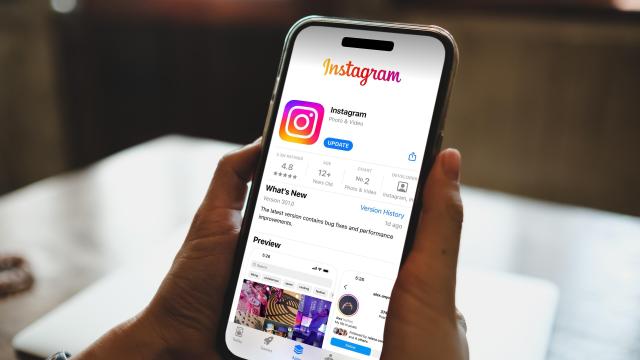Meta’s bread and butter has long been its user-centric targeted ad business, but European regulations are forcing the company to rethink how it can monetize its ostensibly free social platforms. The answer? Make users pay up if they prefer not to let their data be used to sell them products.
Last month, a separate report hinted at Meta’s plans to create a paid, ad-free option on its platforms, and a new report from The Wall Street Journal offers fresh details for what kind of ad-free service users could expect, including an expected cost. According to the Journal, European users would need to pay a little less than $US14 a month to get the ad-free version of Instagram or Facebook on their phones. To get an ad-free version of Facebook and Instagram on desktop would cost about $US10.50 a month, plus an extra $US6 for each linked account. The extra fee on mobile is reportedly due to the notorious 30% Apple tax.
The ploy is Meta’s attempt to comply with major regulations from the European Union. For one, there’s the General Data Protection Regulation, which in part applies privacy and security regulations on big tech. There’s also the more recent Digital Markets Act that focuses on scaling back platforms’ various walled gardens. Back in August, Meta wrote in a blog post that it was planning to seek user consent before allowing companies to advertise based on user data for people in the EU. The post specifically mentions the DMA and GDPR.
The Journal reported based on unnamed sources that Meta has already met with privacy regulators in Ireland and Belgium to share their paid subscription plan. Gizmodo contacted Irish privacy officials but we did not immediately hear back.
There’s no hint whether regulators could agree to Meta’s plans, but the company does have some legal precedent for its plans. In a recent ruling involving Meta’s compliance with the GDPR, the Court of Justice of the European Union gave options for how the company could comply with EU data regulations. One paragraph mentions how the company could charge an “appropriate fee” for an alternative to use the platform that didn’t include targeted ads.
A Meta spokesperson told us, “Meta believes in the value of free services which are supported by personalized ads. However, we continue to explore options to ensure we comply with evolving regulatory requirements. We have nothing further to share at this time.”
Those prices are a real doozy, though they’re not completely out of the ordinary for modern content sharing. After a recent price hike, an ad-free YouTube Premium costs $US14 a month. It’s also akin to many ad-free offerings on streaming services.
While 2022 and 2023 have become the years where streaming services gave in to the siren song of advertising, next year could be the turning point for “free” social media. On Monday, Android Authority was the first to point out code within TikTok that indicated a test of a $US5-a-month subscription fee is underway. Users who pay would be able to eschew ads completely. On Tuesday, TikTok confirmed to TechCrunch the ByteDance-owned company was indeed testing an ad-free experience in an English-speaking country outside the U.S.
The thing is, this ad-free TikTok experience may only cover ads served by TikTok, not the ad campaigns created by influencers on the platform. TikTok, as a monolithic force in the social media industry, is going to face similar problems as Meta under the DMA as well as different regulatory restrictions such as the Digital Services Act. That regulation came up alongside the DMA and mandates that digital services be much more transparent about their ad recommendation algorithms.
ByteDance is also one of those companies listed as one of the six big “gatekeepers” of tech that need to comply with the DMA. That means TikTok and others like Microsoft, Google, and Meta are restricted from pushing their own services as defaults on their platforms. It also forces companies to have some interoperability between messaging and web browsing services.
Gizmodo reached out to TikTok for comment on whether the paid subscription is an effort to comply with the DSA, but we did not immediately hear back.
Meta platforms are still flagging among younger users under the weight of competition from the likes of TikTok, but the EU regulations are likely to put even more pressure on the Mark Zuckerberg-owned tech giant. That’s not even mentioning the company’s latest app, the Twitter clone Threads. Despite immense initial interest, the app’s userbase has substantially declined.
Now, according to unnamed sources talking to The Information, Instagram heads are hoping that influencers and creators can give them hints on how to make Threads big again. Developers are also reportedly trying to figure out how to make their app the best place for up-to-date information about goings-on. The platform has tried to be the safe, sanitary version of a microblogging site by eschewing all news, even to the extent that it has been limiting search results for topics like “covid,” or “vaccines.”
